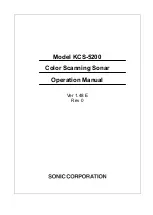
Operation Manual
FarSounder, Inc.
F31552 (Rev. 3.8.0)
Page 63 of 69
not detecting actual smaller objects. It is recommended that the user view the 3D Sonar Display with color
mapped to Signal Level to best determine the general reflectivity level of the wave induced bubbles. From
this, the user can set the In-Water Squelch appropriately.
Vessel Wakes are another source of bubbles. Their bubbles are created by the hull forcing air into the
water as the vessel cuts through the water and by the propulsion system creating cavitation. Vessel wakes
generally reach a depth no greater than the draft of the vessel from which they were created. These bubbles
clouds tend to be a mixture of large and small bubbles. The larger bubbles reflect strong echoes back to the
sonar and dissipate relatively quickly (generally within a couple of minutes). The smaller bubbles tend to
disburse the sonar energy without reflecting many strong echoes back to the sonar. They dissipate slowly
and can be trapped in the water for 10 minutes or more. Generally, if the path of the vessel is still visible at
the surface of the water, wake induced bubbles are still present.
Figure C.4. Wake interference
From far away, vessel wakes generally appear on the sonar as a long line of in-water targets similar to a jetty
or pier wall. However, once the sonar enters the wake area, normal operation will generally be disrupted
since the bubbles are blocking the outgoing transmit energy directly at the transducer. When inside a wake,
the Hydrophone Data viewer inside the System Status Display will show a short period of strong energy
followed by a period of almost no energy. Figure C.4, “Wake interference” shows an example of the sonar
inside a wake. The short, strong energy seen is the transmit signal as it passes through the transducer
before the bubbles block the signal. Once the sonar passes through a wake, normal operation will resume.
Turbulent Current Flows around stationary objects like pilings and buoys produce bubble clouds mostly
through cavitation. In general, these bubble clouds consist of small to medium sized bubbles. This means
that sometimes the object in the water creating the turbulence will be masked by the small bubbles
dissipating the sound with few strong reflections back to the sonar. Generally, this effect will only be seen
when approaching such objects from down current. In other situations, the mediums sized bubbles will
dominate and the sonar will detect a slightly fluctuating “tail” to the actual object. Like wakes, if the sonar
enters a turbulence field, normal operation of the sonar will generally be disrupted until the sonar passes
through the turbulence.
4. Sea State Limitations
In addition to creating bubbles, increased sea states can have additional effects on the sonar system. The
most obvious is transducer movement. Inside the Transducer Module is a roll and pitch sensor. This sensor
will significantly stabilize the image shown to the user when the vessel is undergoing rolling and pitching
up to 20 degrees. Though the Transducer Module should stay submerged, should heavy pitching bring the
unit out of the water occasionally, the unit will not be damaged. However, should the unit be transmitting or
receiving during that period, no image will be seen. Additionally, if the unit is in the water and a wave trough

























